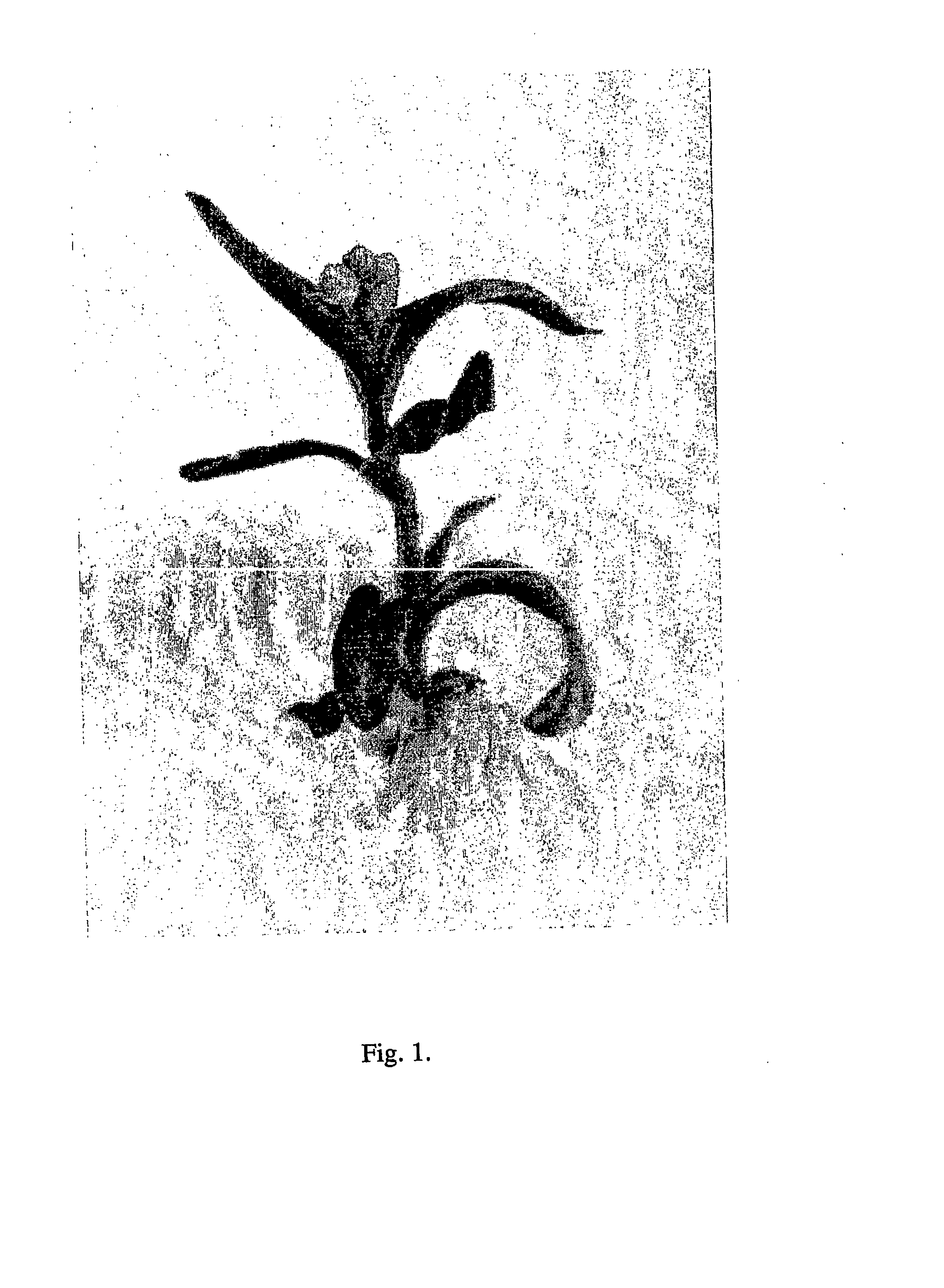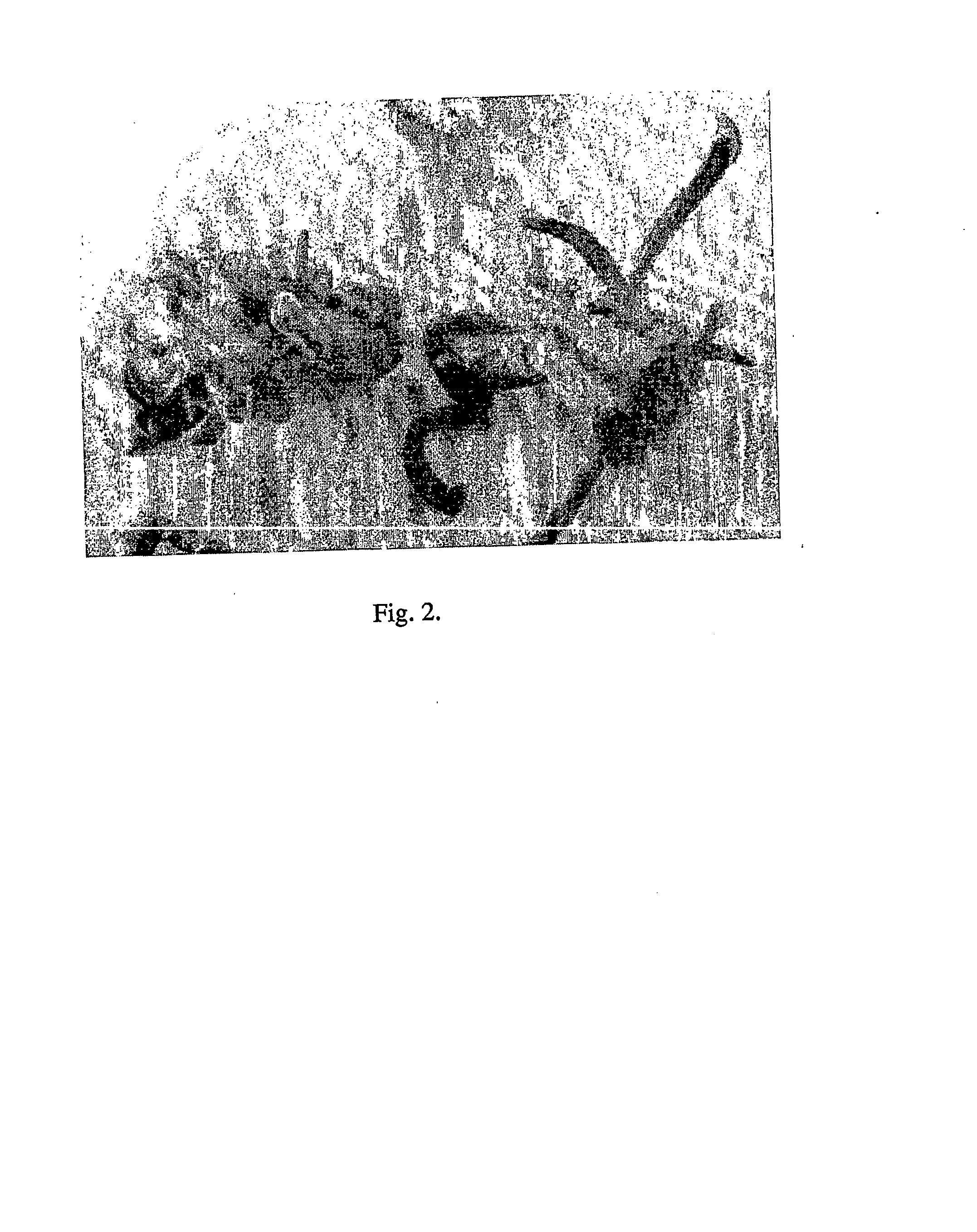Transformation system in camelina sativa
- Summary
- Abstract
- Description
- Claims
- Application Information
AI Technical Summary
Benefits of technology
Problems solved by technology
Method used
Image
Examples
example 1
[0253] Transformation Protocol for Camelina sativa cv. Calena with Agrobacterium tumefaciens Strain LBA4404 Harboring the Binary Plasmid pGPTV-HPT with uidA Intron Containing Gene.
[0254] The seeds of Camelina sativa plant grown in greenhouse were sterilized by immersing in 70% ethanol for 1 min and then treating for 10 min with Na-hypochlorite solution (3% active Cl.sup.-) with an addition of Tween-20 (1 drop per 100 ml). After sterilization the seeds were washed three times in sterile water and placed on solid Murashige and Skoog (MS) agar medium (Murashige and Skoog, Physiol. Plant. 15:472-493, 1962) without sugars for germination. Sterilized seeds were germinated and grown 2-3 weeks on solid Murashige and Skoog (MS) medium without hormones (FIG. 1). Green leaves served as a source of explants for transformation procedure.
[0255] Agrobacterium tumefaciens strain LBA4404 carrying pGPTV-HPT-GUSint vector was grown overnight at 28.degree. C. with shaking in liquid YEB medium (Lichtens...
example 2
[0257] Transformation Protocol for Camelina sativa cv. Calinca with Agrobacterium tumefaciens Strain C58C1 pGV3850 Harboring the Binary Ti Vector with Kanamycin Selection.
[0258] Seeds were taken from greenhouse grown Camelina sativa cv. Calinca plants (no older than 4 months). Transformation efficiency increases from 66% to 100% if donor plants are grown in greenhouse.
[0259] 10 Days Before Excision of the Explants.
[0260] Seeds of Camelina sativa were sterilized and placed in vitro on Murashige and Skoog (MS) agar medium without sucrose and grown at temperatures of 25.degree. C. (day) and 18.degree. C. (night) as described in Example 1.
[0261] 1.sup.st Day.
[0262] A fresh colony of Agrobacterium tumefaciens strain C58C1pGV3850 carrying binary pGPTV-KAN vector (Becker et al., Plant Mol. Biol. 20:1195-1197, 1992) containing uidA-int gene under 35S promoter and selectable marker gene nptII, was inoculated in 3 ml of liquid YEB medium supplemented with 25 mg / l rifampicin (Rif) and 50 mg / l ...
example 3
[0276] Transformation Protocol for Camelina sativa cv. Calena with Agrobacterium tumefaciens Strain 4 C58C1 pGV3850 Harboring Cointegrative Ti DNA Without Selection of Transgenic Tissues.
[0277] Seeds were taken from greenhouse grown Camelina sativa cv. Calena plants (no older than 4 months). Transformation efficiency increases from 66% to 100% if donor plants are grown in greenhouse.
[0278] 10 Days Before Explants Excision.
[0279] Seeds were sterilized and placed in vitro on Murashige and Skoog (MS) medium without sucrose and grown at temperatures of 25.degree. C. (day) and 18.degree. C. (night) as described in Example 1.
[0280] 1.sup.st Day.
[0281] A fresh colony of C58C1pGV3850 with interned Ti DNA from pHTT-HPT (Elomaa et al., Bio / Technology 11:508-511, 1993) vector containing GUS gene under 35S promoter and hpt selectable marker was inoculated in 3 ml of liquid YEB supplemented with 25 mg / l rifampicin (Rif) and 100 mg / l spectinomycin (Spe) or streptomycin (Str). The bacteria were gr...
PUM
| Property | Measurement | Unit |
|---|---|---|
| Fraction | aaaaa | aaaaa |
| Fraction | aaaaa | aaaaa |
| Fraction | aaaaa | aaaaa |
Abstract
Description
Claims
Application Information
 Login to View More
Login to View More - R&D
- Intellectual Property
- Life Sciences
- Materials
- Tech Scout
- Unparalleled Data Quality
- Higher Quality Content
- 60% Fewer Hallucinations
Browse by: Latest US Patents, China's latest patents, Technical Efficacy Thesaurus, Application Domain, Technology Topic, Popular Technical Reports.
© 2025 PatSnap. All rights reserved.Legal|Privacy policy|Modern Slavery Act Transparency Statement|Sitemap|About US| Contact US: help@patsnap.com



